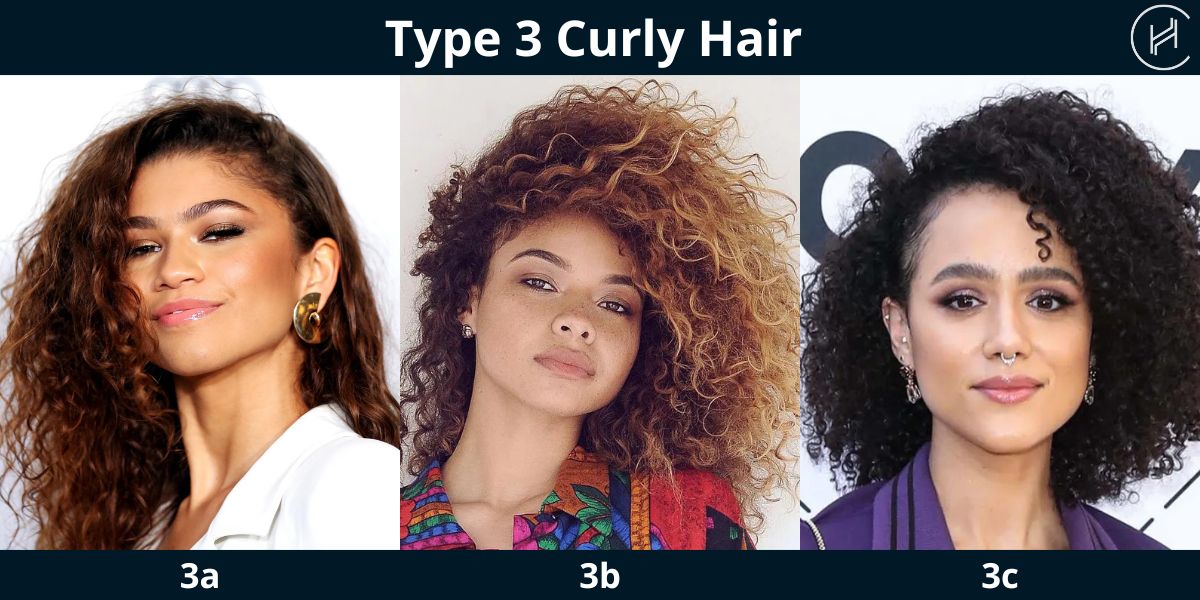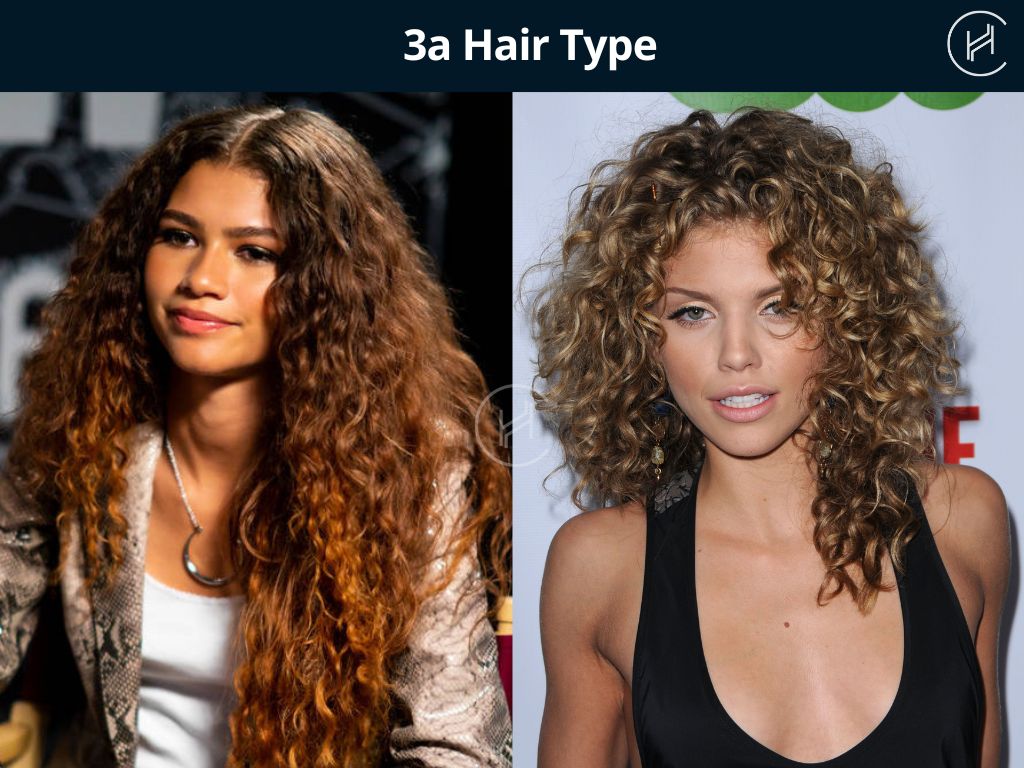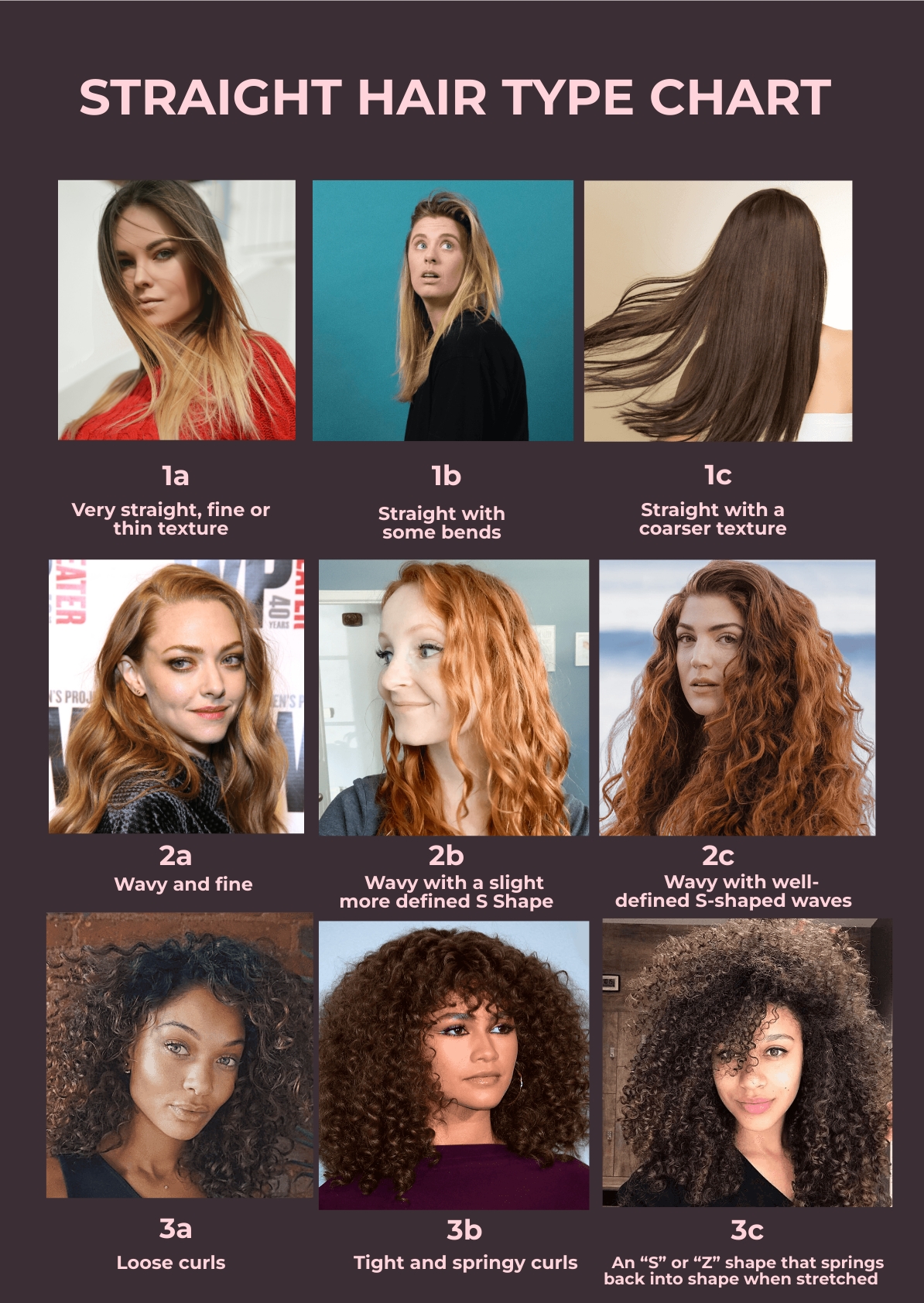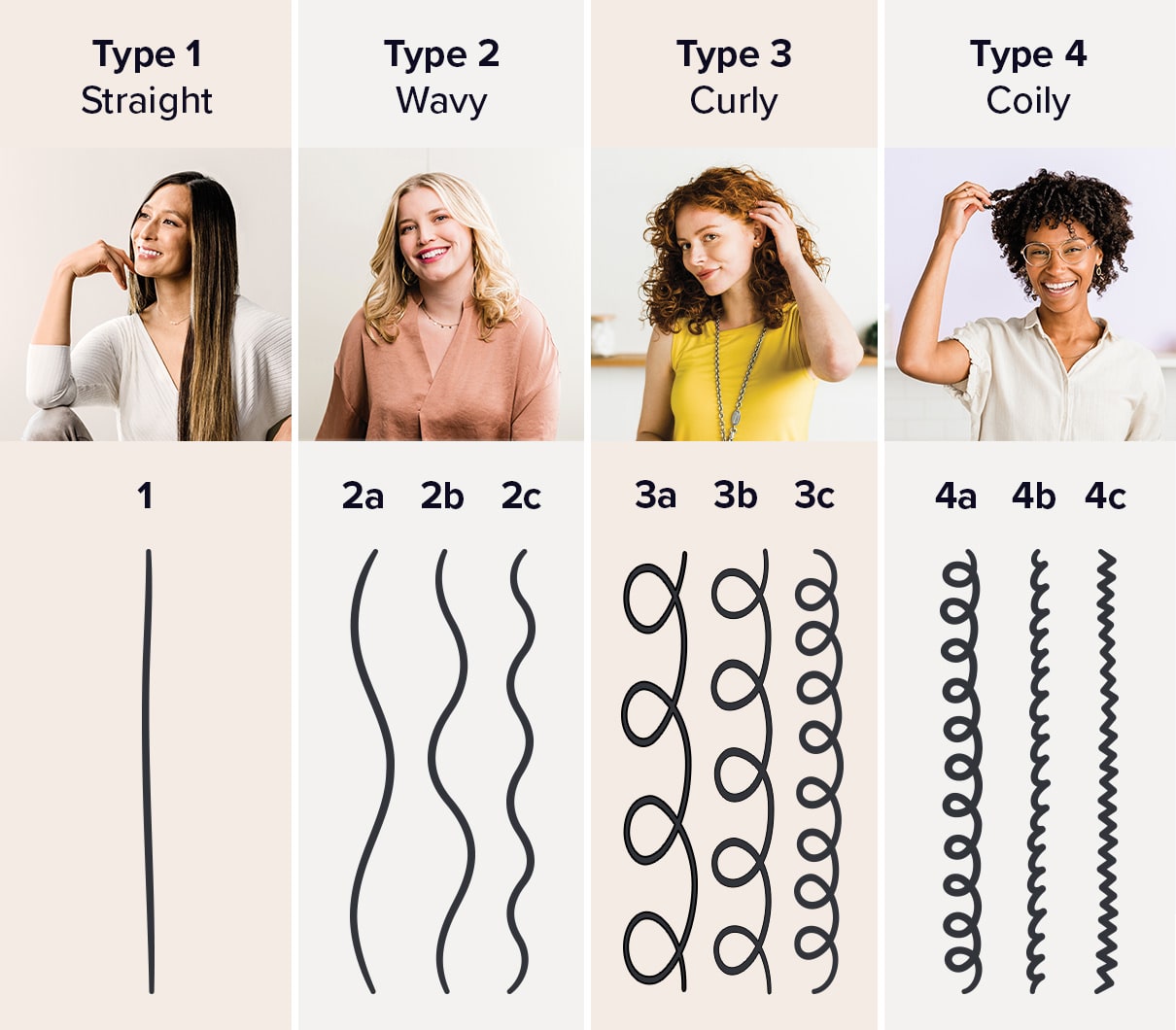
Hair is a deeply personal expression, a canvas for our identity and mood. Yet, beneath the endless possibilities of cuts and colors lies a fundamental truth: your natural hair type dictates not only how your hair behaves but also the most effective ways to style and care for it. Understanding whether your strands are straight, wavy, or curly is the first step towards unlocking your hair’s full potential, transforming daily struggles into effortless beauty.
Far from being a limitation, embracing your hair’s inherent texture is an act of self-love and the secret to achieving truly stunning results. This article delves into the distinct characteristics, common challenges, and tailored styling techniques for three primary hair types: straight, wavy, and curly/coily. By understanding your unique texture, you can choose the right products, master appropriate techniques, and cultivate a haircare routine that celebrates your natural beauty, leading to healthier, more manageable, and consistently fabulous hair.
Straight Hair: The Sleek Canvas
Straight hair, characterized by its lack of natural curl, typically falls smoothly from the roots to the ends. It often possesses a natural sheen dueating to its flat surface, which reflects light beautifully. This hair type can range from fine and thin to thick and coarse, each with its own nuances, but all share the common trait of a straight growth pattern.
Characteristics:
- Natural Shine: The smooth cuticle allows for excellent light reflection.
- Prone to Oiliness: Sebum from the scalp travels easily down the straight shaft, leading to quicker oil buildup.
- Can Lack Volume: Without natural bends, straight hair can sometimes appear limp or flat, especially at the roots.
- Holds Styles Differently: While it can be styled into curls or waves, these often fall out quickly without strong hold products or specific techniques.
Common Challenges:
- Limpness and Lack of Body: Achieving and maintaining volume can be a constant battle.
- Greasy Roots: Frequent washing might be necessary, which can sometimes lead to over-stripping and increased oil production.
- Difficulty Holding Curls: Curls often relax into waves or fall out entirely within hours.
- Static and Flyaways: Especially in dry climates, straight hair can be prone to static electricity.
Styling Techniques for Straight Hair:
-
Sleek and Polished: This is the quintessential straight hair look.
- Flat Ironing: For ultra-sleekness, use a high-quality flat iron on dry hair, ensuring you apply a heat protectant beforehand. Work in small sections for best results.
- Smoothing Products: Anti-frizz serums, smoothing creams, and lightweight oils can tame flyaways and enhance shine. Apply sparingly to avoid weighing down the hair.
- High Ponytails & Buns: These styles naturally look chic and polished on straight hair, especially when paired with a strong hold gel or hairspray for a slicked-back effect.
-
Voluminous Blowouts: To add body and bounce.
- Root Lifting: Apply a volumizing mousse or root-lifting spray to damp roots before blow-drying.
- Round Brushing: Use a round brush while blow-drying, lifting sections at the root and directing airflow upwards. For maximum volume, blow-dry hair upside down initially.
- Velcro Rollers: After blow-drying, set sections in large velcro rollers, letting them cool completely before removing. This locks in volume and a gentle bend.
- Dry Shampoo: A quick spritz of dry shampoo at the roots can add instant lift and absorb excess oil on non-wash days.
-
Adding Texture and Movement:
- Soft Waves: Use a large barrel curling iron (1.5 inches or larger) or a flat iron to create loose, beachy waves. Alternate the direction of curls for a more natural look. Gently brush through with fingers or a wide-tooth comb once cooled.
- Braids for Overnight Waves: Braid damp hair (one large braid for loose waves, multiple smaller braids for tighter ones) and let it air dry overnight. Unravel in the morning for heat-free texture.
- Texturizing Spray: A light texturizing spray can add grip and subtle volume without making hair feel sticky.
Product Recommendations:
- Shampoo & Conditioner: Volumizing or clarifying formulas to prevent buildup and add lift.
- Styling Products: Root-lifting sprays, volumizing mousses, dry shampoo, lightweight heat protectants, light-hold hairsprays, shine serums (used sparingly).
Care Tips:
- Avoid Over-Washing: While straight hair gets oily quickly, over-washing can strip natural oils, leading to the scalp producing more. Try extending wash days with dry shampoo.
- Gentle Brushing: Use a boar bristle brush to distribute natural oils from roots to ends, enhancing shine and reducing oiliness at the scalp.
- Cool Rinses: A final rinse with cool water can help seal the cuticle, boosting shine.
- Regular Trims: To maintain healthy ends and prevent split ends from traveling up the shaft.
Wavy Hair: The Versatile Middle Ground
Wavy hair occupies the beautiful space between straight and curly, characterized by an "S" shaped pattern. This hair type is incredibly versatile, capable of being styled to look nearly straight or enhanced to appear more curly. Waves can range from loose, barely-there bends to more defined, consistent S-patterns, and can be fine, medium, or coarse in texture.
Characteristics:
- S-Shaped Pattern: The defining characteristic, varying in tightness and consistency.
- Prone to Frizz: The lifted cuticle, inherent in the wave pattern, makes it more susceptible to humidity and frizz.
- Can Be Dry: While not as dry as curly hair, natural oils don’t travel down the S-shape as easily as they do on straight hair, leading to some dryness.
- Versatility: Can be straightened, enhanced for more curl, or left in its natural wave.
Common Challenges:
- Frizz: A primary concern, especially in humid conditions.
- Inconsistent Wave Pattern: Some sections might be wavier than others, leading to an uneven look.
- Product Buildup: Wavy hair can be prone to feeling weighed down by heavy products.
- Lack of Definition: Waves can sometimes look shapeless or "poofy" without proper styling.
Styling Techniques for Wavy Hair:
-
Defined Waves: To enhance and consolidate your natural S-pattern.
- Scrunching: After applying a curl cream or mousse to damp hair, gently scrunch sections upwards towards the scalp. This encourages the wave pattern to form.
- Diffusing: Use a diffuser attachment on your blow dryer on a low heat and speed setting. Gently cup sections of hair in the diffuser and lift towards the scalp. This dries hair without disturbing the wave pattern and adds volume.
- Air-Drying with Product: For a more natural, effortless look, apply a lightweight curl enhancer or gel to wet hair and allow it to air dry completely without touching it.
-
Beach Waves: For a relaxed, effortless vibe.
- Sea Salt Spray: Apply to damp or dry hair and scrunch for a textured, matte finish.
- Texturizing Sprays: Similar to sea salt sprays, these add grip and volume, making waves look more lived-in.
- Braiding Damp Hair: Create loose braids (one or two large ones) on damp hair and let them dry. Unravel for soft, heat-free waves.
-
Enhancing Volume:
- Root Clipping: While hair is damp and setting, use small clips at the roots to lift them away from the scalp, creating volume as it dries.
- Flipping Head Upside Down: When diffusing or air-drying, flip your head upside down to encourage roots to lift.
Product Recommendations:
- Shampoo & Conditioner: Sulfate-free and moisturizing formulas to combat frizz and dryness without weighing down waves.
- Styling Products: Lightweight curl creams, mousses, gels, sea salt sprays, anti-frizz serums, heat protectants.
Care Tips:
- Gentle Drying: Use a micro-fiber towel or an old cotton t-shirt to gently blot excess water from hair instead of rubbing vigorously, which can cause frizz.
- Wide-Tooth Comb: Detangle hair gently when wet and conditioned, using a wide-tooth comb or your fingers. Avoid brushing dry wavy hair, as it can disrupt the wave pattern and cause frizz.
- Deep Conditioning: Incorporate a deep conditioning treatment once a week or bi-weekly to maintain moisture and elasticity.
- Co-Washing or Low-Poo: Consider alternating traditional shampoo with a cleansing conditioner (co-wash) or a low-lather, sulfate-free shampoo to preserve natural oils.
Curly/Coily Hair: The Defined Texture
Curly and coily hair types are defined by their distinct, often tight, S-shaped or Z-shaped patterns. This hair type is typically the driest of the three, as the natural oils from the scalp struggle to travel down the intricate twists and turns of the hair shaft. It often appears voluminous, vibrant, and incredibly diverse, ranging from loose curls to tightly coiled strands (coils).
Characteristics:
- Pronounced Curl Pattern: Ranges from loose spirals to tight corkscrews or zig-zag patterns.
- Prone to Dryness: The most significant characteristic, requiring consistent moisture.
- Shrinkage: Curly hair can appear much shorter when dry than it is when wet due to its elasticity and curl pattern.
- Fragile: The bends in the hair shaft can be points of weakness, making it more prone to breakage if not handled gently.
- High Porosity (Often): The cuticle layers can be more open, allowing moisture to enter and leave easily.
Common Challenges:
- Dryness and Frizz: Constant battle to maintain moisture and prevent frizz.
- Tangles and Knots: The intricate curl patterns can easily intertwine, leading to tangles.
- Breakage: Due to dryness and tangles, curly hair is more susceptible to breakage.
- Definition vs. Volume: Achieving defined curls without sacrificing volume can be a balancing act.
Styling Techniques for Curly/Coily Hair:
-
Wash-and-Go: Embracing your natural curl pattern with minimal manipulation.
- Product Application: Apply leave-in conditioner, curl cream, and a strong-hold gel to soaking wet hair, section by section, to clump curls and enhance definition.
- Drying: Air-dry or diffuse on low heat/speed, avoiding touching the hair until it’s completely dry to prevent frizz. Once dry, gently "scrunch out the crunch" from the gel cast for soft, defined curls.
-
Twist-Outs/Braid-Outs: For stretched, defined waves or curls.
- Sectioning: Apply products (leave-in, cream, gel) to damp, detangled sections of hair.
- Twisting/Braiding: Create two-strand twists or braids, ensuring they are taut but not too tight.
- Drying & Unraveling: Allow hair to dry completely (overnight is ideal). Gently unravel the twists/braids, separating strands for volume and definition. Apply a light oil to your hands before unraveling to minimize frizz.
-
Protective Styles: Minimizing manipulation and protecting ends.
- Braids & Twists: Box braids, cornrows, Senegalese twists, Marley twists – these styles tuck away the ends of your hair, protecting them from environmental damage and daily manipulation.
- Buns & Updos: Low manipulation styles that keep hair off the shoulders and neck.
- Dreadlocks: A permanent protective style that requires specific maintenance.
-
Voluminous Afros: For maximum volume and shape.
- Picking: Once hair is dry, use an afro pick to gently lift and shape the hair from the roots, working outwards.
- Fluffing: Gently separate curls with your fingers for added volume, focusing on the roots.
Product Recommendations:
- Shampoo & Conditioner: Ultra-moisturizing, sulfate-free, and silicone-free formulas.
- Styling Products: Leave-in conditioners, deep conditioners, rich curl creams, butters, oils (e.g., shea butter, coconut oil, jojoba oil), strong-hold gels, curl activators.
Care Tips:
- Moisture is Key: Use the LOC (Liquid-Oil-Cream) or LCO (Liquid-Cream-Oil) method to layer products and seal in moisture.
- Gentle Detangling: Always detangle on wet, conditioned hair using a wide-tooth comb or your fingers, starting from the ends and working your way up.
- Silk/Satin Protection: Sleep on a silk or satin pillowcase or wear a silk/satin bonnet to reduce friction, frizz, and moisture loss.
- Low Manipulation: Avoid excessive brushing, combing, or touching dry hair, as this can lead to frizz and breakage.
- Deep Conditioning: Essential for maintaining moisture and elasticity. Do it weekly or bi-weekly.
- Regular Trims: To remove split ends and maintain healthy curl definition.
Conclusion
Understanding your hair type is more than just a label; it’s a roadmap to effective haircare and styling. Whether your hair is straight, wavy, or curly/coily, each texture possesses unique qualities that, when understood and nurtured, can be transformed into a crown of confidence. Embrace your natural texture, experiment with the techniques and products recommended for your specific hair type, and don’t be afraid to consult with a professional stylist who specializes in your hair texture. By celebrating your hair’s inherent beauty, you’ll not only achieve your best look but also foster a healthier, more loving relationship with your unique strands.





